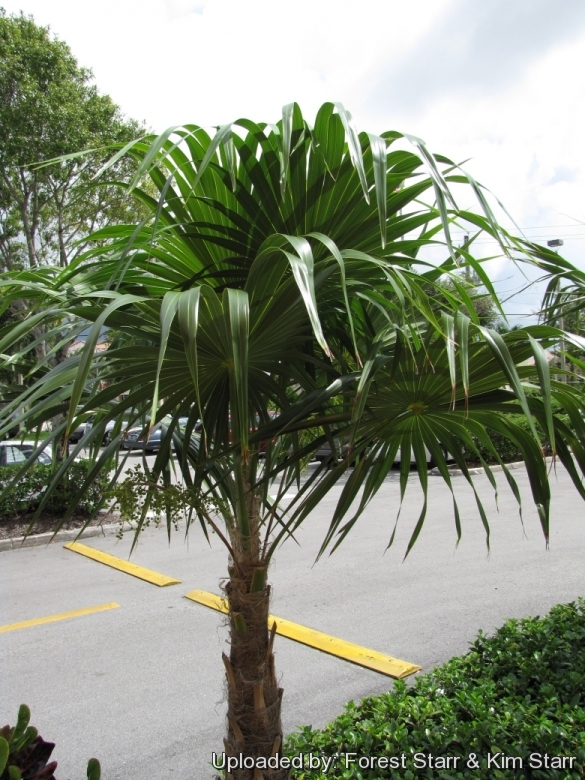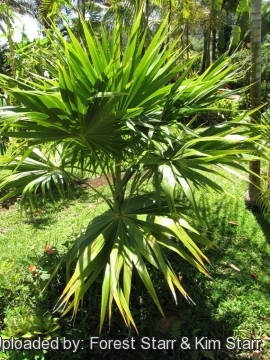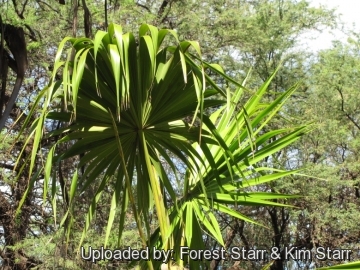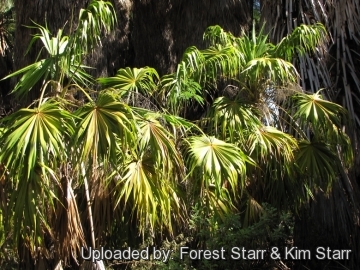
Thrinax radiata Photo by: Forest Starr & Kim Starr
Habit at Marriott Boynton Beach, Florida. September 23, 2009.
Origin and Habitat: South Florida (Monroe County Keys, Miami-Dade, Collier counties and Keewadin Island), South-east Mexico, Honduras to Nicaragua, and much of the northern Caribbean islands (Bahamas, western Cuba,
Cayman Islands, Jamaica, Hispaniola, Puerto Rico).
Habitat: It grows in coastal forest and hammocks on moist, well-drained limestone or sandy soils, with humus rich top layer.
Ecology: Provides food and cover for wildlife. Larval host plant for Asbolis capucinus butterflies.
Synonyms:
See all synonyms of Thrinax radiata
back
Accepted name in llifle Database:Thrinax radiata Lodd. ex Schult. & Schult.f.Syst. Veg., ed. 15 bis [Roemer & Schultes] 7(2): 1301 (1830)Synonymy: 16
back
Common Names include:
ENGLISH: Thatch pole (Jamaica), Thatchpalm (Jamaica), Thatch palm (USA -Jamaica), Silktop palmetto (USA -Jamaica), Silktop thatch (USA -Jamaica), Silktop thatchpalm (USA -Jamaica), Salt water pimento (Belize), Salt water pimenta (Belize), Salt water palmetto (Belize), Large fruitedd thatchpalm, Large fruitedd thatch palm (Bahamas), Jamaica thatch palm (Bahamas), Fan palm (Belize), Broom thatch (Jamaica), Green thatch palm, Florida Thatch Palm
FRENCH (Français): Palmier à balai, Latanier de mer, Latanier, Palmier-éventai de Floride
MAYA: Chit, Ch'íit
PORTUGUESE (Português): Palmeira leque brilhante
SPANISH (Español): , Miraguano de lana (Cuba), Guano de campeche (Cuba), Guano campeche (Cuba), Guanillo (Dominican Republic), Guano de costa (Cuba)
Description: Thrinax radiataSN|24720]]SN|24720]] is a medium sized, solitary, very slow-growing tree or shrub-like fan palm very attractive when young, becoming much taller than broad when mature.
Trunk: 3-6 m tall (occasionally up to 9 m tall), 9-15 cm in diameter, usually solitary, slender, straight, erect, smooth. Typically the base of the trunk has lots of dead roots that protrude above the ground. The entire trunk of young specimens is matted with fibres held between old leaf bases, while in older specimens the mid and lower trunk is rough and grey.
Crown (canopy): Regular, with 12-20 leaves, more dense and and globular in full sun and open and airy under shade.
Crownshaft: None.
Leaves: Palmate, induplicate, nearly circular (fan-shaped), about 60-90(-150) cm in diameter, deeply split about halfway into 50-60 slightly folded segments up to 60 cm long and 5 cm wide, with drooping and split leaf tips, glossy yellowish-green to dark green on top and light green on the underside. Hastula pointed, petiole unarmed 60-90 cm long.
Flower: The inflorescence is 90 cm long or more and arches downward, sometimes
extending beyond the frond. The bisexual flowers are white and showy.
Flowering Season: All year; peak in spring. Palms as short as 180 cm will begin flowering.
Fruit: Round white drupe 5-8 mm in diameter. All year, but are more abundant in the autumn.
Notes: Initially Thrinax palms look a lot like to the closely related Cocothrinax genus but the trunk looks very different as this genus has split leaf bases, while Coccothrinax palms do not. The white drupes also distinguishes it from Coccothrinax. The latter group of palms have yellow or black drupes. Thrinax palm also differs from both the thatch palm (Leucothrinax morrisii) and the silver palm (Coccothrinax argentata) by lacking the silvery white leaf undersurfaces.
Bibliography: Major references and further lectures
1) Forest & Kim Starr Thrinax radiata (Florida thatch palm). Plants of Hawaii. <http://www.starrenvironmental.com>. Downloaded on 21 August 2014.
2) Michael J. Balick, Hans T. Beck “Useful Palms of the World” Columbia University Press 1990
3) Thomas H. Everett “The New York Botanical Garden Illustrated Encyclopedia of Horticulture” Volume 10 Taylor & Francis, 1982
4) Andrew Henderson “Field Guide to the Palms of the Americas” Princeton University Press, 1997
5) Jack Krempin “Palms & Cycads Around the World” Horwitz Grahame, 1990
7) Wikipedia contributors. "Thrinax." Wikipedia, The Free Encyclopedia. Wikipedia, The Free Encyclopedia, 8 Sep. 2014. Web. 11 Sep. 2014.
8) John Dransfield, Natalie W. Uhl “Genera Palmarum: the evolution and classification of palms” Kew Pub., 2008
9) Don Ellison, Anthony Ellison “Cultivated Palms Of The World” UNSW Press, 01/May/2001
10) Govaerts, R. & Dransfield, J. “World Checklist of Palms”. The Board of Trustees of the Royal Botanic Gardens, Kew. 2005.
11) Palmpedia contributors. "Thrinax radiata" Palmpedia, PALM ENCYCLOPEDIA, <http://www.palmpedia.net> Downloaded on 26 Aug. 2014
12) Robert Lee Riffle, Paul Craft “An Encyclopedia of Cultivated Palms” Timber Press, Portland 2007
13) "Thrinax radiata." PACSOA Palms and Cycads wiki , <http://www.pacsoa.org.au> Accessed on 28 Aug. 2014
14) M.M. Grandtner "Elsevier's Dictionary of Trees Volume 1: North America" Volume 1 Elsevier, 08/Apr/2005
15) "Flora of North America" volume 22 Oxford University Press 2000
16) Daniel F. Austin "Florida Ethnobotany" CRC Press, 29/Nov/2004
17) Gil Nelson, Christopher J. Earle, Richard Spellenberg "Trees of Eastern North America" Princeton University Press, 27/Jul/2014
18) Gil Nelson "The Trees of Florida: A Reference and Field Guide" Pineapple Press Inc, 30/Sep/2010
 Habit at Garden of Eden Keanae, Maui, Hawaii (USA). March 30, 2011. Photo by: Forest Starr & Kim Starr
Habit at Garden of Eden Keanae, Maui, Hawaii (USA). March 30, 2011. Photo by: Forest Starr & Kim Starr Leaves at Resort Management Group Nursery Kihei, Maui, (USA). February 09, 2011. Photo by: Forest Starr & Kim Starr
Leaves at Resort Management Group Nursery Kihei, Maui, (USA). February 09, 2011. Photo by: Forest Starr & Kim Starr Habit at Resort Management Group Nursery Kihei, Maui, Hawaii (USA). February 09, 2011. Photo by: Forest Starr & Kim Starr
Habit at Resort Management Group Nursery Kihei, Maui, Hawaii (USA). February 09, 2011. Photo by: Forest Starr & Kim Starr Fruit at Marriott Boynton Beach, Florida. September 23, 2009. Photo by: Forest Starr & Kim Starr
Fruit at Marriott Boynton Beach, Florida. September 23, 2009. Photo by: Forest Starr & Kim StarrCultivation and Propagation: It is cultivated in tropical, subtropical regions and planted in gardens and parks. If you needs a small low maintenance, but graceful looking palm, it doesn't get any better than Thrinax radiataSN|24720]]SN|24720]].
Growth Rate: Slow. Growth averages no more than 18 cm a year.
Soil: It grows well in the high pH of calcareous and sandy material (This material is frequently used for roadway and residential construction) and benefit from decomposing organic matter added to the soil, but is adaptable to many kinds of well drained soils.
Fertilization: It requires little of fertilizer. Use a perfect fertilizer diet including all micro nutrients and trace elements or slow release fertilizer applied during the growing season, or according to package directions, using a fertilizer specifically formulated for palms.
Water Requirements: It is tolerant of short periods of drought once established, though it prefers evenly moist but not consistently wet medium. When supplied with adequate moisture and fertilizer it is also fairly fast growing. It dislikes soggy soils.
Light: It prefers bright sunny locations, but it also does well in part shade with some direct sunlight. It will survive in rather heavy shade but "stretches" to lose its compact shape.
Salt tolerance: It is somewhat tolerant of seaside spray and may be grown near the sea, best if given some protection (behind a dune, building, etc.). It does not take well to being inundated by salt or brackish water.
Wind resistance: High.
Hardiness: It is a relatively cold tolerant species and is able to survive temperatures as low as -3° C ( U.S.D.A. Zone: 10A-12B).
Roots: Usually not a problem
Maintenance: The fronds are persistent. For the healthiest and most attractive plant, keep the palm pruned. As the old fronds die, these should be trimmed off and the leaf bases allowed to dry out, but do not prune if the frond still has some green colour and avoid removing fronds above an imaginary 180 degree horizon. Palms recycle nutrients from dead or dying fronds and use them for healthier fronds. These days it is popular to remove all but a few of the suckers and to prune the leaves to form a cluster of clear trunked "mini" palms.
Pest and diseases: Aphids; scales.
Human hazards: None
Uses: It is used massively in gardening and landscaping in many tropical and subtropical part of the world though in sheltered areas it will survive short periods below freezing point. It is frequently used along roadways, in parking lots, yards, patios, seaside and wherever there is limited space. It is also excellent in containers and urns. And thanks to its drought resistance and durability to heat it can thrive in harsh urban conditions.
Traditional uses: The stems are used as stakes and leaves in the manufacture of hats and roofing.
Propagation: By seed. Can be grown from de-pulped seed. Place container in light shade or full sun.













